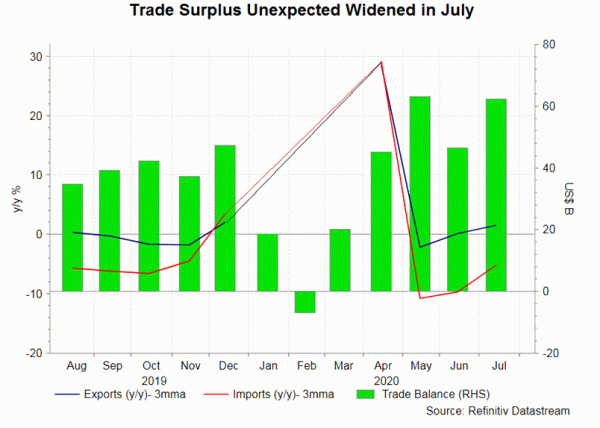China’s trade data surprised to the upside in July. This was mainly driven by strong exports, offsetting decline in imports. Exports gained +7.2% y/y in July, following a 0.5% increase a month. This has beaten consensus of a -0.6% drop. From a month ago, exports rose +5.7$, after climbing +1.8% in June. Imports unexpectedly dropped -1.4% y/y, missing consensus of +0.9% increase, and a +2.7% growth in June. As a result, trade surplus widened to US$62.3B, from+46.4B in the prior month.
Concerning exports, exports in medical equipment soared +78.0% y/y in July, after a +100% gain a month ago. Shipment of plastic articles jumped +90.6% y/y, accelerating from +84.1% increase in June. Expansion of exports in automatic data processing machines and electronic integrated circuits both accelerated remarkably. Country-wise, shipment to the US jumped +12.5% y/y in July. This marks a significant acceleration from +1.4% in the prior month. Growth of ASEAN exports also accelerated to +14% y/y, from June’s +1.6%. However, exports to European Union countries slowed to +3.4% y/y, while those to Japan moderated to +2% y/y, during the month.
Growth of imports to China decelerated in major commodities. For instance, copper imports grew +72% y/y in July, easing from +74.2% in June. Iron ore imports moderated sharply to +10.6% y/y from June’s +24.9%.
US and China are scheduled to have a mid-year of the Phase I trade deal next week (August 15). Under the Phase 1 trade deal, agreed in principal in Ocotber 2019 and signed in January 2020, China had agreed to buy US$200B worth of US goods (agricultural, energy and tech) in 2 years, of which about US$40-50B are agricultural goods. Meanwhile, China would also open financial services sector and enact new protections against intellectual property (IP) theft. In return, the US had agreed to suspend and reduce tariff on certain Chinese goods. However, China’s actual purchase has been below the agreed levels due to the global coronavirus pandemic. For instance, imports of agricultural goods have been lower than the 2017 level, far behind the 50% increase needed to meet the 2020 target of US$36.5B. Little has been on the market opening-up and IP protection.













